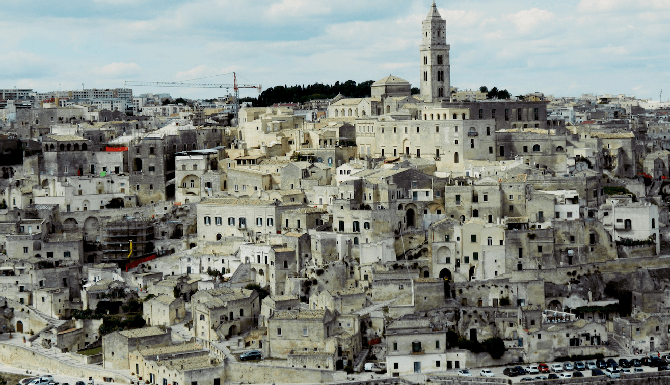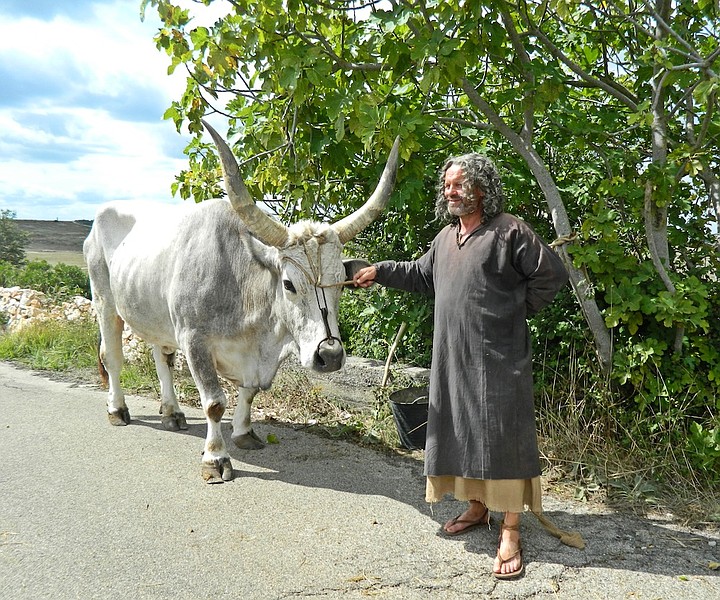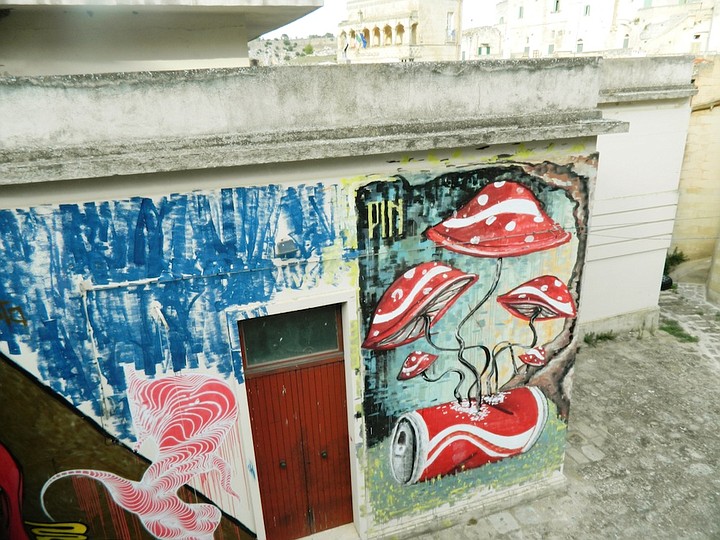 Facebook
Facebook
 X
X
 Instagram
Instagram
 TikTok
TikTok
 Youtube
Youtube

In what is the instep of Italy’s boot, the first forays into Italy from North Africa came to settle in Matera 10,000 years ago. Living quarters were fashioned in both the limestone caves and built outward from the rock.
Much like America’s Appalachia, the people there developed their own style of thriving in harsher living conditions, and also like Appalachia, they grew to be scorned by their fellow countrymen. Their practices included living with the family donkey – so necessary on precarious steps – inside their caves. Like other ill-conceived “War(s) on Poverty,” the ancient district was forcibly evacuated in 1954. In the late 1970s, bohemian types squatted in the old residences, and in the 1980s, some reinvestment in the area began. It's slow going, but visionaries are opening businesses to cater to extraordinary residents and tourists.

Matera’s continued resemblance to what we think Biblical sites looked like has led to location filming for such movies as Passion of the Christ. It’s been designated a UNESCO heritage site and just won the 2019 designation for European Capital of Culture.
The oldest noble family of Matera was Gattini; their Counts lived in what is now Palazzo Gattini (hotel). Lovingly restored, this is an exclusive boutique hotel with only 20 rooms; movie star Sean Bean nearly ran smack into me one night at the hotel bar’s outdoor patio. There are arched cathedral ceilings, murals and artwork in the rooms, some of which are duplexes or suites. Huge bath sheets, bidet, a mini-fridge and WiFi ups the luxury level. I seriously looked forward to their breakfast buffets in the cellar, laden with fresh breads, exotic fruits and house-made Burrata cheese.
I’m ashamed to admit that I didn’t get to the underground spa/pool; I was out and about during most of its open hours and confused about the fees to use it. Luxury isn’t cheap, and I didn’t want any surprise charges on my card. However, I did enjoy the 24-hour upstairs patio that overlooks the whole town. The night views are magical!
Baccanti is as special as Matera. You descend into the subterranean piazza and cavern restaurant, lit like a movie set. The quintessential recipes of Matera plus the finest liqueurs and local wines are served. The region has piquant olive oils and wild herbs. I was struck how their ancient, traditional recipes (and those in other area restaurants) were decidedly unsalty and left in their natural state. Is it because they were poor and salt – "salary" – was dear? After all, this is the part of the world where the infamous, but interesting tasting pasta di grano arso (pasta from burnt flour) comes from.
At Ristoranti Kappador, you’re right in the center of what’s the developed part of the ancient town. One part is a pizzeria and the other is the “restaurant.” There’s a rooftop dining/drinking area that adds glamour to a dressy-casual place. They feature grilled meats and fish, with wines specially selected to go with those flavors.
Nearby Miglionico, Italy's Il Ritrovo del Cima is a farm-to-table restaurant sourcing almost everything they serve on-site. Patrons walk past animal pens, swollen ripe grapes and figs, green herbs. When people talk about terroir, the flavors of the land, they're surely here.
The cuisine of Miglionico shares many of the simple, fresh flavors of its neighbor, Matera: steamed greens (arugula, turnip greens, broccoli rabe), made-that-day pot cheese, chickpeas. However, because they're on a farm – without the tradition of cooking in donkey-inhabited caves or gleaning them in wild fields like in Matera – there are aged products on their table: dry-cure sausages, aged country ham. The restaurant has some outdoor long tables.

In Matera, see history without being cooped up in a museum. At Parco della Murgia Materana, wear your sturdy shoes – regular hikers will have no problem – to see the layout of the area from a plateau that overlooks the city. There are prehistoric, Byzantine and Middle Ages caves, some of which were churches. Those who go with guides will have inside access to caves that are behind protective iron grills. This is a hike where you can get some spectacular photo shots.
The District Caveoso has homes that are hundreds of years old, stacked on top of each other. On top is where people bury their dead: the only place the dead are above the living! In this make-do area, donkey bones are used as part of the structural support for old homes.
At the main square in the “Old City,” Piazza Vittorio Veneto, enter what was the main cistern for the city in the Middle Ages. Rediscovered in the 1990s, dive teams saw its historic import and it was pumped out. If you’ve explored caves, the dark and damp environment as well as long, winding stairs won’t surprise you.

Santa Lucia Alle Malve is a cave church dating back to the 9th century. Though it has an unassuming outside, the inside is beautiful and startlingly intact. There are wonderful frescoes, some 1,000 years old. Because Matera had such a low self-image, they thought for centuries the frescoes were painted by Byzantine artists. As it turns out, they’re completely local.
Caves are part of the fabric of Matera’s civic life: Casa Cava, the world’s only underground community arts center, hosts events like theatrical products, art exhibits and jazz concerts.
One of the region’s last towns to be evacuated in the ‘50s is now known as the “ghost town” of Craco. You can only see it on a guided hard-hat tour, as it’s mostly left as it was. On the steep, precarious paths up a mountain lined with fragrant wild fig trees, I got why donkeys were so important. Cars and bikes can’t do it! Sadly, thieves were able to reach many homes, removing carved fireplace mantles and stained glass.
It wasn’t always bleak and desolate; in its heyday, Craco had about 15 families that lived like royalty from agriculture, selling wheat and beans.


In what is the instep of Italy’s boot, the first forays into Italy from North Africa came to settle in Matera 10,000 years ago. Living quarters were fashioned in both the limestone caves and built outward from the rock.
Much like America’s Appalachia, the people there developed their own style of thriving in harsher living conditions, and also like Appalachia, they grew to be scorned by their fellow countrymen. Their practices included living with the family donkey – so necessary on precarious steps – inside their caves. Like other ill-conceived “War(s) on Poverty,” the ancient district was forcibly evacuated in 1954. In the late 1970s, bohemian types squatted in the old residences, and in the 1980s, some reinvestment in the area began. It's slow going, but visionaries are opening businesses to cater to extraordinary residents and tourists.

Matera’s continued resemblance to what we think Biblical sites looked like has led to location filming for such movies as Passion of the Christ. It’s been designated a UNESCO heritage site and just won the 2019 designation for European Capital of Culture.
The oldest noble family of Matera was Gattini; their Counts lived in what is now Palazzo Gattini (hotel). Lovingly restored, this is an exclusive boutique hotel with only 20 rooms; movie star Sean Bean nearly ran smack into me one night at the hotel bar’s outdoor patio. There are arched cathedral ceilings, murals and artwork in the rooms, some of which are duplexes or suites. Huge bath sheets, bidet, a mini-fridge and WiFi ups the luxury level. I seriously looked forward to their breakfast buffets in the cellar, laden with fresh breads, exotic fruits and house-made Burrata cheese.
I’m ashamed to admit that I didn’t get to the underground spa/pool; I was out and about during most of its open hours and confused about the fees to use it. Luxury isn’t cheap, and I didn’t want any surprise charges on my card. However, I did enjoy the 24-hour upstairs patio that overlooks the whole town. The night views are magical!
Baccanti is as special as Matera. You descend into the subterranean piazza and cavern restaurant, lit like a movie set. The quintessential recipes of Matera plus the finest liqueurs and local wines are served. The region has piquant olive oils and wild herbs. I was struck how their ancient, traditional recipes (and those in other area restaurants) were decidedly unsalty and left in their natural state. Is it because they were poor and salt – "salary" – was dear? After all, this is the part of the world where the infamous, but interesting tasting pasta di grano arso (pasta from burnt flour) comes from.
At Ristoranti Kappador, you’re right in the center of what’s the developed part of the ancient town. One part is a pizzeria and the other is the “restaurant.” There’s a rooftop dining/drinking area that adds glamour to a dressy-casual place. They feature grilled meats and fish, with wines specially selected to go with those flavors.
Nearby Miglionico, Italy's Il Ritrovo del Cima is a farm-to-table restaurant sourcing almost everything they serve on-site. Patrons walk past animal pens, swollen ripe grapes and figs, green herbs. When people talk about terroir, the flavors of the land, they're surely here.
The cuisine of Miglionico shares many of the simple, fresh flavors of its neighbor, Matera: steamed greens (arugula, turnip greens, broccoli rabe), made-that-day pot cheese, chickpeas. However, because they're on a farm – without the tradition of cooking in donkey-inhabited caves or gleaning them in wild fields like in Matera – there are aged products on their table: dry-cure sausages, aged country ham. The restaurant has some outdoor long tables.

In Matera, see history without being cooped up in a museum. At Parco della Murgia Materana, wear your sturdy shoes – regular hikers will have no problem – to see the layout of the area from a plateau that overlooks the city. There are prehistoric, Byzantine and Middle Ages caves, some of which were churches. Those who go with guides will have inside access to caves that are behind protective iron grills. This is a hike where you can get some spectacular photo shots.
The District Caveoso has homes that are hundreds of years old, stacked on top of each other. On top is where people bury their dead: the only place the dead are above the living! In this make-do area, donkey bones are used as part of the structural support for old homes.
At the main square in the “Old City,” Piazza Vittorio Veneto, enter what was the main cistern for the city in the Middle Ages. Rediscovered in the 1990s, dive teams saw its historic import and it was pumped out. If you’ve explored caves, the dark and damp environment as well as long, winding stairs won’t surprise you.

Santa Lucia Alle Malve is a cave church dating back to the 9th century. Though it has an unassuming outside, the inside is beautiful and startlingly intact. There are wonderful frescoes, some 1,000 years old. Because Matera had such a low self-image, they thought for centuries the frescoes were painted by Byzantine artists. As it turns out, they’re completely local.
Caves are part of the fabric of Matera’s civic life: Casa Cava, the world’s only underground community arts center, hosts events like theatrical products, art exhibits and jazz concerts.
One of the region’s last towns to be evacuated in the ‘50s is now known as the “ghost town” of Craco. You can only see it on a guided hard-hat tour, as it’s mostly left as it was. On the steep, precarious paths up a mountain lined with fragrant wild fig trees, I got why donkeys were so important. Cars and bikes can’t do it! Sadly, thieves were able to reach many homes, removing carved fireplace mantles and stained glass.
It wasn’t always bleak and desolate; in its heyday, Craco had about 15 families that lived like royalty from agriculture, selling wheat and beans.
Comments